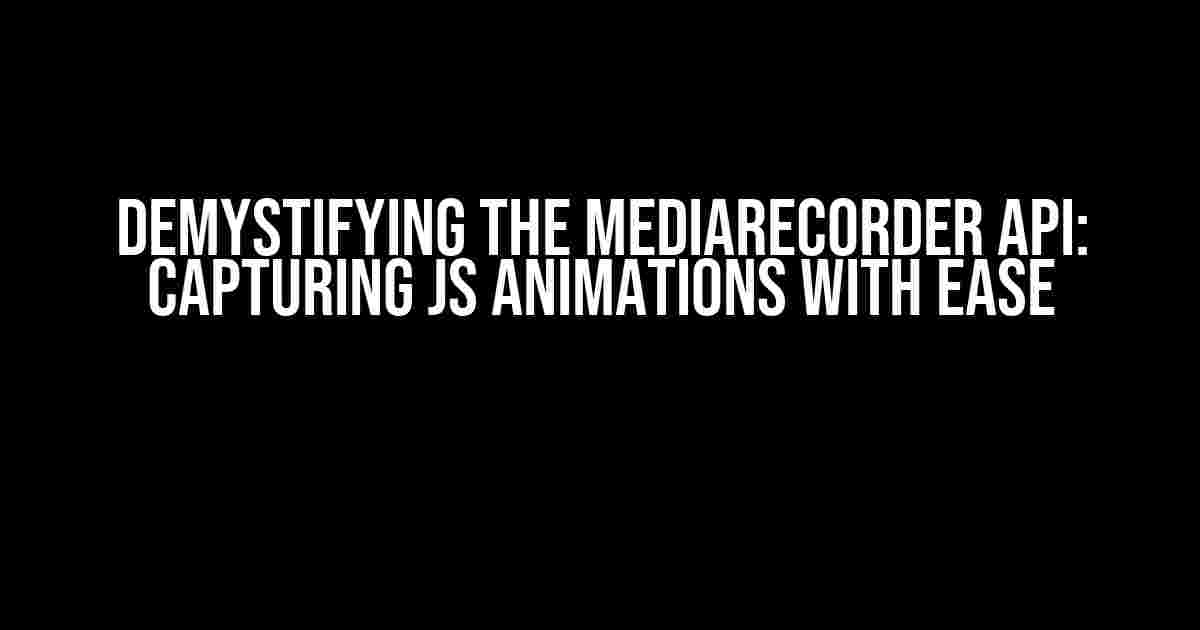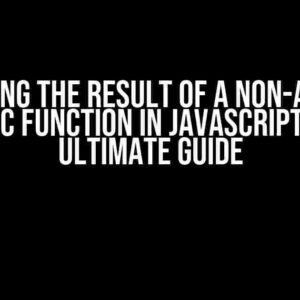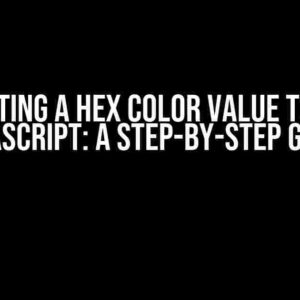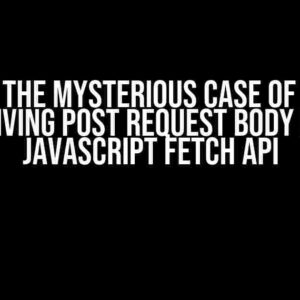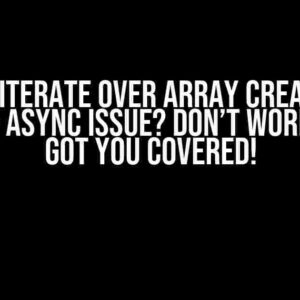Are you tired of struggling to capture your mesmerizing JS animations? Do you find yourself wondering why your blob value is stubbornly stuck on null? Fear not, dear developer, for today we’ll embark on a journey to conquer the MediaRecorder API and unlock the secrets of capturing those animations like a pro!
What is the MediaRecorder API?
The MediaRecorder API is a powerful tool that allows you to record media streams, including audio and video. It’s a game-changer for capturing animations, but it can be a bit finicky. Don’t worry, we’ll break it down into bite-sized chunks, so you can focus on creating stunning animations rather than wrestling with code.
Why do I need to use MediaRecorder?
There are several reasons why you might want to use the MediaRecorder API:
- Animation capture**: Record and save your animations as video files, perfect for sharing or showcasing your work.
- Live streaming**: Use the MediaRecorder API to capture and stream your animations in real-time.
- Debugging**: Record your animations to identify and fix issues, making your development process more efficient.
Preparing Your Animation for Capture
Before we dive into the world of MediaRecorder, make sure your animation is ready for prime time:
- Create a container element**: Add a `
` or other container element to hold your animation. This will make it easier to target and capture the animation.
- Add animation code**: Write your animation logic using JavaScript, CSS, or a combination of both. Make sure it’s working as expected!
- Style and layout**: Ensure your animation container has the correct styles and layout to display your animation correctly.
Capturing the Animation with MediaRecorder
Now that your animation is ready, let’s create a MediaRecorder instance and start capturing:
// Get the animation container element const animationContainer = document.getElementById('animation-container'); // Create a MediaStream and get the video stream const stream = animationContainer.captureStream(); const videoStream = stream.getVideoTracks()[0]; // Create a MediaRecorder instance const mediaRecorder = new MediaRecorder(videoStream, { mimeType: 'video/webm; codecs=vp9' }); // Create a blob array to store the recorded data const recordedBlobs = []; // Start the recording mediaRecorder.start(); // Handle the recorded data mediaRecorder.ondataavailable = event => { if (event.data && event.data.size > 0) { recordedBlobs.push(event.data); } }; // Stop the recording mediaRecorder.stop();Uh-oh! My blob value is still null!
Don’t panic! There are a few common reasons why your blob value might be null:
- animationContainer.captureStream() returns null**: Double-check that your animation container element is correctly identified and that the animation is playing within it.
- videoStream is null or undefined**: Verify that the `getVideoTracks()` method returns a valid video track. You can use the `console.log()` function to inspect the `videoStream` variable.
- recordedBlobs array is empty**: Ensure that the `ondataavailable` event is firing correctly and that the `event.data` property contains valid data. You can use the `console.log()` function to inspect the `event.data` property.
Saving the Recorded Animation as a File
Now that we have the recorded data, let’s save it as a file:
// Create a blob from the recordeddata const blob = new Blob(recordedBlobs, { type: 'video/webm' }); // Create a URL for the blob const url = URL.createObjectURL(blob); // Create an anchor element to download the file const a = document.createElement('a'); a.href = url; a.download = 'animation.webm'; a.click(); // Release the blob URL URL.revokeObjectURL(url);Troubleshooting Tips
Encountering issues with the MediaRecorder API? Here are some troubleshooting tips to help you out:
Issue Solution MediaRecorder is not supported Check browser compatibility. MediaRecorder is supported in most modern browsers, but some older versions might not support it. Animation is not capturing correctly Verify that the animation container element is correctly identified and that the animation is playing within it. Recorded file is corrupted or invalid Check the recorded data and ensure that it’s not empty or null. Verify that the blob type is set correctly (e.g., ‘video/webm’). Conclusion
Capturing JS animations using the MediaRecorder API might seem daunting at first, but with the right guidance, you’ll be creating stunning animations in no time! Remember to prepare your animation, create a MediaRecorder instance, capture the animation, and save the recorded data as a file. Don’t hesitate to reach out if you encounter any issues – and most importantly, have fun creating!
Happy coding, and don’t forget to share your captured animations with the world!
Frequently Asked Question
Stuck with capturing your JS animation using mediaRecorder? Don’t worry, we’ve got you covered! Check out these frequently asked questions and their answers to troubleshoot the issue of getting a null blob value.
Why am I getting a null blob value when trying to capture my JS animation using mediaRecorder?
This could be due to a timing issue. Make sure you’re calling `mediaRecorder.requestData()` after the animation has finished playing. You can do this by adding a callback function to the animation’s completion event or by using a setTimeout function with a suitable delay.
How do I ensure that my mediaRecorder is properly initialized and configured to capture my JS animation?
Double-check that you’ve created a new MediaStream and added the video track to it. Also, ensure that you’ve initialized the mediaRecorder with the correct options, such as the mimeType and audioBitsPerSecond. Additionally, make sure you’ve started the mediaRecorder using the `start()` method before the animation begins.
Can I use mediaRecorder to capture a JS animation in a cross-browser compatible way?
Yes, mediaRecorder is supported in most modern browsers, including Chrome, Firefox, and Edge. However, you may need to use a polyfill or fallback for older browsers. Additionally, be aware of potential differences in browser implementations and adjust your code accordingly.
How can I debug my mediaRecorder configuration and identify the cause of the null blob value?
Use the browser’s developer tools to inspect the mediaRecorder object and its properties. You can also add console logs or debug statements to track the state of the mediaRecorder and the animation. Additionally, try capturing a simple video or audio stream to isolate the issue and narrow down the potential causes.
Are there any alternative approaches to capturing a JS animation, aside from using mediaRecorder?
Yes, you can use other libraries or techniques, such as canvas-to-blob, RecordRTCPromises, or ffmepg.js. Each approach has its own advantages and disadvantages, so consider your specific requirements and choose the best fit for your project.

